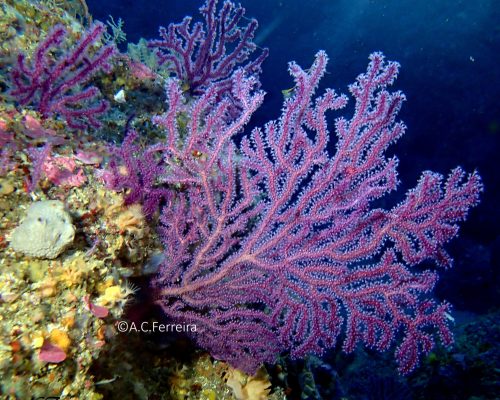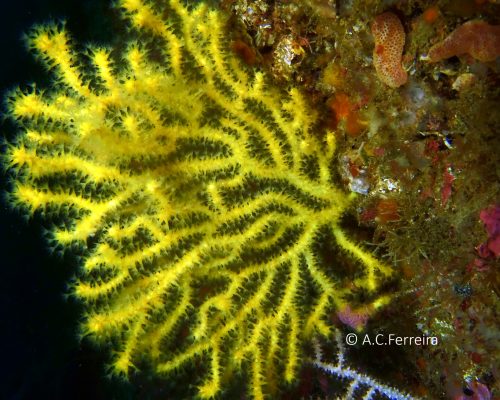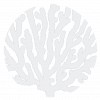picture © Emanueal Gonçalves
Gorgonians – sea fans and sea whips
The coral habitats in the Mediterranean Sea and the Atlantic Ocean consist mostly of gorgonians (sea fans and sea whips) and a few species of hard corals.
Gorgonians belong to a group of corals that do not have a hard internal skeleton. Instead, their skeleton is made of a different material that is more flexible than that of hard corals. Additionally, gorgonians have millions of tiny calcareous needles located in the coral’s surface tissue that gives it extra support and flexibility.
Coral Diversity
Gorgonians – sea fans and sea whips
The coral habitats in the Mediterranean Sea and the Atlantic Ocean consist mostly of gorgonians (sea fans and sea whips) and a few species of hard corals.
Gorgonians belong to a group of corals that do not have a hard internal skeleton. Instead, their skeleton is made of a different material that is more flexible than that of hard corals. Additionally, gorgonians have millions of tiny calcareous needles located in the coral’s surface tissue that gives it extra support and flexibility.
.
picture © Emanueal Gonçalves
Eunicella verrucosa
– Common or Pink Sea Fan –
This coral is one of the most common species in shallow-water habitats of the European Atlantic coast and we find it very frequently in fishing nets. It is called the pink sea fan, common fan or warty gorgonian. That’s because its skeleton has many small bumps into which the polyps retract (see our section on Coral Biology to learn more about what a polyp is). We can find Eunicella verrucosa 15 m to 400 m deep. Its colors can vary from fully white to pink or orange. This species is currently listed as vulnerable in the IUCN Red List of Threatened Species.
picture © Emanueal Gonçalves
Eunicella verrucosa
– Common or Pink Sea Fan –
This coral is one of the most common species in shallow-water habitats of the European Atlantic coast and we find it very frequently in fishing nets. It is called the pink sea fan, common fan or warty gorgonian. That’s because its skeleton has many small bumps into which the polyps retract (see our section on Coral Biology to learn more about what a polyp is). We can find Eunicella verrucosa 15 m to 400 m deep. Its colors can vary from fully white to pink or orange. This species is currently listed as vulnerable in the IUCN Red List of Threatened Species.
picture © Emanueal Gonçalves
Leptogorgia
sarmentosa
– Orange Sea Fan –
Leptogorgia sarmentosa is also known as the orange sea fan, but the name is not entirely accurate. We find the coral in many color variations. It can be fully yellow, terra-cotta orange, purple, purple and yellow or completely white. Variants with differently colored tips are particularly beautiful. The coral branches are very slender, the colony is bushy, and can grow up to over 60 cm in height. The purple and yellow variant is often (inaccurately) considered a separate species called Leptogorgia lusitanica, which is reminiscent of underwater flames. This is the color variant most often found in Portugal. The species can be found at depths between 8 and 200 meters.
picture © Emanueal Gonçalves
Leptogorgia
sarmentosa
– Orange Sea Fan –
Leptogorgia sarmentosa is also known as the orange sea fan, but the name is not entirely accurate. We find the coral in many color variations. It can be fully yellow, terra-cotta orange, purple, purple and yellow or completely white. Variants with differently colored tips are particularly beautiful. The coral branches are very slender, the colony is bushy, and can grow up to over 60 cm in height. The purple and yellow variant is often (inaccurately) considered a separate species called Leptogorgia lusitanica, which is reminiscent of underwater flames. This is the color variant most often found in Portugal. The species can be found at depths between 8 and 200 meters.


picture © Emanueal Gonçalves
Paramuricea cf. grayi
For a long time, our Paramuricea was thought to be of the same species as the red gorgonian Paramuricea clavata from the Mediterranean sea.
However, our recent genetic studies revealed that the Portuguese populations are genetically different and a distinct species, which should be called Paramuricea cf. grayi, a species originally described from Madeira.
As for Paramuricea clavata in the Mediterranean, we find two color variants in the Atlantic: a deep purple color variant and a vibrant yellow color variant, which are also genetically distinct and may represent separate species. Resolving that question is part of our research.
When in contact with air, both color variants immediately turn black presumably due to a chemical reaction of the color pigments.


Paramuricea cf. grayi
For a long time, our Paramuricea was thought to be of the same species as the red gorgonian Paramuricea clavata from the Mediterranean sea.
However, our recent genetic studies revealed that the Portuguese populations are genetically different and a distinct species, which should be called Paramuricea cf. grayi, a species originally described from Madeira.
As for Paramuricea clavata in the Mediterranean, we find two color variants in the Atlantic: a deep purple color variant and a vibrant yellow color variant, which are also genetically distinct and may represent separate species. Resolving that question is part of our research.
When in contact with air, both color variants immediately turn black presumably due to a chemical reaction of the color pigments.
Hard or stony corals
They have an external calcareous skeleton that makes them much more rigid than the soft corals such as gorgonians. Many tropical reefs consist of the calcareous skeletons produced by stony corals.
Hard or stony corals
They have an external calcareous skeleton that makes them much more rigid than the soft corals such as gorgonians. Many tropical reefs consist of calcareous skeletons produced by stony corals.
Dendrophyllia cornigera
– Yellow Coral –
Dendrophyllia cornigera is a hard coral found in the Mediterranean Sea and NE Atlantic Ocean. This species often inhabits hard soil and occurs at depths ranging from 30 to 1200 m. Similar to Dendrophyllia ramea, this coral forms rigid tree-like colonies consisting of 1-2 cm thick polyps and about 30 to 40 cm in size. Despite its deep distribution, the living coral is bright yellow and often possesses an orange-tinted mouth.
Dendrophyllia cornigera
– Yellow Coral –
Dendrophyllia cornigera is a hard coral found in the Mediterranean Sea and NE Atlantic Ocean. This species often inhabits hard soil and occurs at depths ranging from 30 to 1200 m. Similar to Dendrophyllia ramea, this coral forms rigid tree-like colonies consisting of 1-2 cm thick polyps and about 30 to 40 cm in size. Despite its deep distribution, the living coral is bright yellow and often possesses an orange-tinted mouth.
Dendrophyllia ramea
– Orange Tree Coral –
Dendrophyllia ramea is also called the tree coral or the orange tree coral. This species can form tree-like colonies of up to 1 meter in height. We find them mostly between 30 to 200 meters depth, though there are repors of sightings at 700 meters. Dendrophyllia ramea has beautiful bright colors of orange and white or neon yellow tentacles. The colors are in the living tissue and the skeleton itself is white.
Dendrophyllia ramea
– Orange Tree Coral –
Dendrophyllia ramea is also called the tree coral or the orange tree coral. This species can form tree-like colonies of up to 1 meter in height. We find them mostly between 30 to 200 meters depth, though there are repors of sightings at 700 meters. Dendrophyllia ramea has beautiful bright colors of orange and white or neon yellow tentacles. The colors are in the living tissue and the skeleton itself is white.
You can help us save and protect these diverse species.
Learn more about coral’s biology.
You can help us save and protect these diverse species.
Learn more about coral’s biology.

PLANT A CORAL
save our coral gardens

PLANT A CORAL
save our coral gardens
